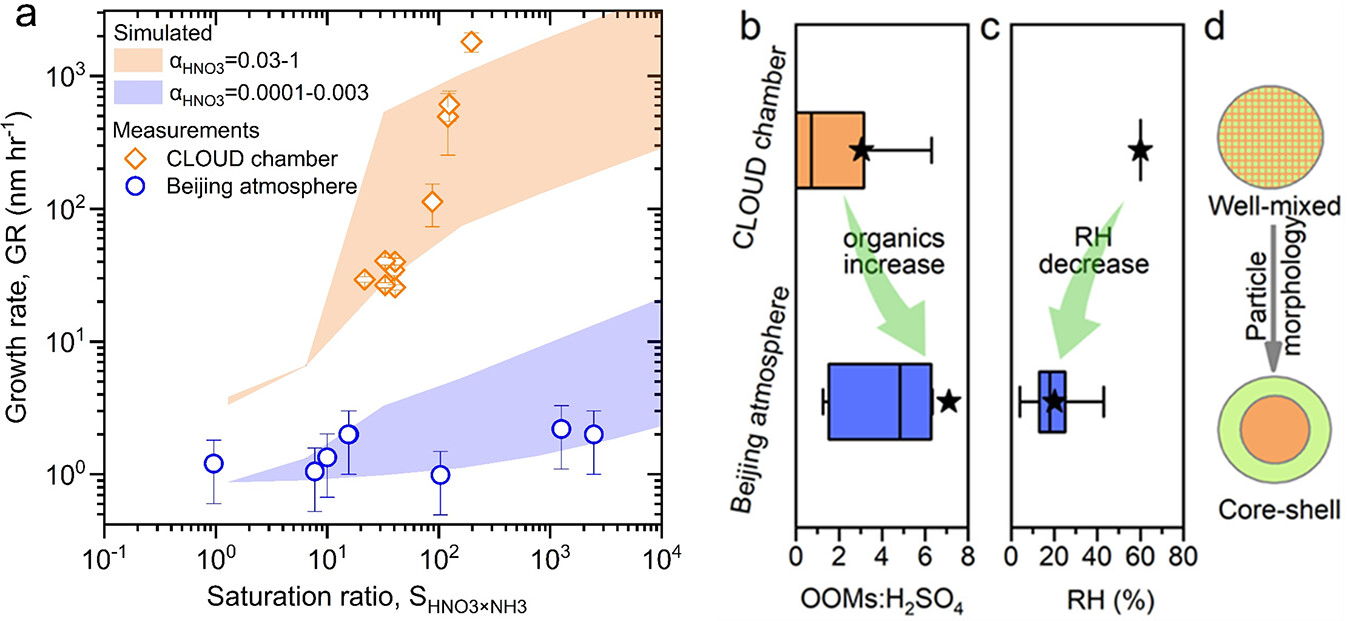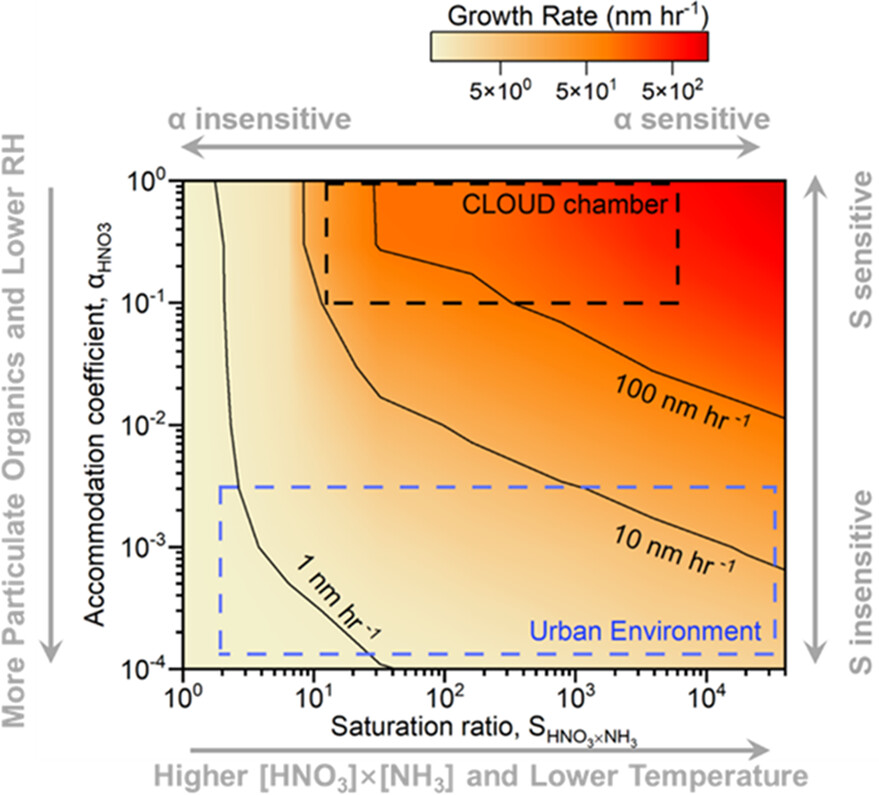New particle formation is a major source of global atmospheric particle number concentration. The subsequent growth of these newly formed particles can lead to significant climate and environmental effects. Professor Jiang Jingkun’s research group from School of Environment, Tsinghua University, in collaboration with Professor James N. Smith from the University of California, Irvine, discovered that the contribution of nitric acid condensation to the growth of new particles in Beijing’s winter low-temperature environment is significantly lower than the experiment results reported by European Council for Nuclear Research (CERN). They revealed that the main reason is that organic components of the nanoparticles greatly reduce the uptake efficiency (quantitatively represented by the parameter accommodation coefficient) of nitric acid at low relative humidity. They proposed that an “inorganic core–organic shell” morphology might exist for atmospheric nanoparticles.
New particle formation and growth greatly influence air quality and the global climate. Recent CERN Cosmics Leaving Outdoor Droplets (CLOUD) experiments proposed that in cold atmospheres with highly supersaturated HNO3 and NH3, nanoparticles can grow rapidly (up to 1000 nm·h–1). Related reports commented that this experimental result is of great significance for understanding polluted urban atmospheres under low-temperature conditions.
This study provides direct observational evidence through long-term atmospheric observations conducted in Beijing. According to the study, in winter Beijing with persistent highly supersaturated HNO3 and NH3, the growth rates of new particles were only 0.8–5 nm·h–1, and nitrate contributed less than ∼14% of the 8–40 nm nanoparticle composition. This indicates that the accommodation coefficients of HNO3 by the nanoparticles in urban Beijing atmosphere is 2–4 orders of magnitude lower than those in the CERN CLOUD experiment. Compared to the conditions in the CLOUD chamber, urban Beijing atmosphere has lower relative humidity and the nanoparticles have higher fractions of organic components. This also indicates that an “inorganic core–organic shell” nanoparticle morphology might exist for nanoparticles in winter Beijing, which leads to significantly lower accommodation coefficients of HNO3.

Figure 1. Comparison of experimental results in the Beijing atmosphere with those in the CLOUD chamber: (a) saturation ratio (SHNO3´NH3), growth rate, and accommodation coefficients of HNO3 (αHNO3), (b) proportion of gaseous precursors, (c) ambient relative humidity, and (d) possible particle morphology
This study, based on atmospheric observations, demonstrates that the uptake of gaseous components by nanoparticles may be influenced by their composition and morphology. It provides a new perspective for research on the contribution of semi-volatile components to the growth of new particles. Despite the presence of supersaturated HNO3 and NH3 in both Beijing’s winter atmosphere and CERN’s CLOUD chamber, the difference in accommodation coefficients leads to a significantly different contribution of HNO3 to the growth of new particles. Furthermore, the supersaturated HNO3 and NH3 observed in Beijing may also exist in the atmospheres of most cities or under cold conditions at high altitudes. In these environments, research on the contribution of HNO3 and NH3 to particle growth also needs to quantitatively analyze the impact of the chemical composition and morphology of new particles on their accommodation coefficients.

Figure 2. The impact of saturation ratio (SHNO3´NH3) and accommodation coefficients on the growth rate of new particles
This research, titled “The Significant Role of New Particle Composition and Morphology on the HNO3-Driven Growth of Particles down to Sub-10 nm”, has been published online in Environmental Science & Technology.
The co-first authors of the paper are Li Yuyang, a doctoral student at the School of Environment, Tsinghua University, and Li Xiaoxiao, an Associate Researcher at Wuhan University. The corresponding authors are Professor Jiang Jingkun and Professor James N. Smith. Academician Hao Jiming, Assistant Professor Zheng Guangjie, doctoral students Li Yiran and Chen Yijing from School of Environment, Tsinghua University, Researcher Cai Runlong from Fudan University, Associate Professor Yan Chao from Nanjing University, Professor Liu Yongchun, graduate students Zhang Yusheng, Guo Yishuo, and Hua Chenjie from Beijing University of Chemical Technology, Professor Markku Kulmala and Professor Veli-Matti Kerminen from the University of Helsinki, provided significant guidance and assistance in establishing the observation platform, instrument data analysis, or model simulation. The research was funded by the National Natural Science Foundation of China, the United States Department of Energy, and the Samsung Global Research Outreach Program.
Link to the paper: https://pubs.acs.org/doi/full/10.1021/acs.est.3c09454





